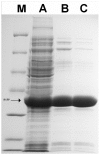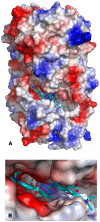A study on the interaction of rhodamine B with methylthioadenosine phosphorylase protein sourced from an Antarctic soil metagenomic library
- PMID: 23383268
- PMCID: PMC3561333
- DOI: 10.1371/journal.pone.0055697
A study on the interaction of rhodamine B with methylthioadenosine phosphorylase protein sourced from an Antarctic soil metagenomic library
Abstract
The presented study examines the phenomenon of the fluorescence under UV light excitation (312 nm) of E. coli cells expressing a novel metagenomic-derived putative methylthioadenosine phosphorylase gene, called rsfp, grown on LB agar supplemented with a fluorescent dye rhodamine B. For this purpose, an rsfp gene was cloned and expressed in an LMG194 E. coli strain using an arabinose promoter. The resulting RSFP protein was purified and its UV-VIS absorbance spectrum and emission spectrum were assayed. Simultaneously, the same spectroscopic studies were carried out for rhodamine B in the absence or presence of RSFP protein or native E. coli proteins, respectively. The results of the spectroscopic studies suggested that the fluorescence of E. coli cells expressing rsfp gene under UV illumination is due to the interaction of rhodamine B molecules with the RSFP protein. Finally, this interaction was proved by a crystallographic study and then by site-directed mutagenesis of rsfp gene sequence. The crystal structures of RSFP apo form (1.98 Å) and complex RSFP/RB (1.90 Å) show a trimer of RSFP molecules located on the crystallographic six fold screw axis. The RSFP complex with rhodamine B revealed the binding site for RB, in the pocket located on the interface between symmetry related monomers.
Conflict of interest statement
Figures










References
-
- Muthuraman G, Teng TT (2009) Extraction and recovery of rhodamine B, methyl violet and methylene blue from industrial wastewater using D2EHPA as an extractant. J Ind Eng Chem 15: 841–846. - PubMed
-
- Truant J, Brett W, Thomas W (1962) Fluorescence microscopy of tubercle bacilli stained with auramine and rhodamine. Henry Ford Hosp Med Bull 10: 287–296. - PubMed
-
- Whitehead KA, Benson P, Verran J (2009) Differential fluorescent staining of Listeria monocytogenes and a whey food soil for quantitative analysis of surface hygiene. Int J Food Microbiol 135: 75–80. - PubMed
-
- Wessely Z, Shapiro SH, Klavins JV, Tinberg HM (1981) Identification of Mallory Bodies with rhodamine B fluorescence and other stains for keratin. Biotech Histochem 56: 169–176. - PubMed
-
- Shapiro SH, Wessely Z (1988) Rhodamine B fluorescence as a stain for amniotic fluid squames in maternal pulmonary embolism and fetal lungs. Ann Clin Lab Sci 18: 451–454. - PubMed
MeSH terms
Substances
LinkOut - more resources
Full Text Sources
Other Literature Sources

